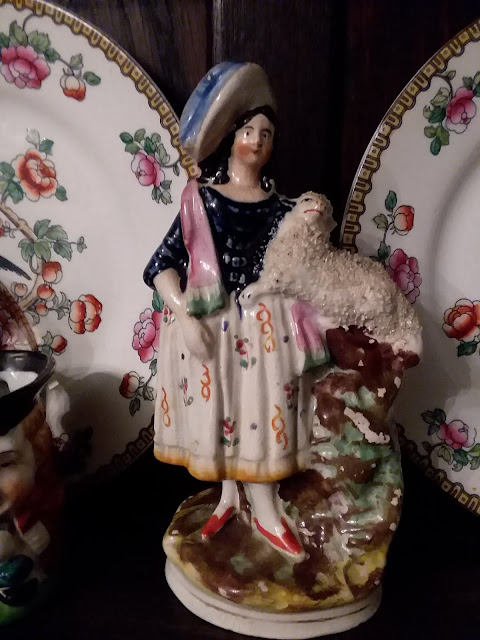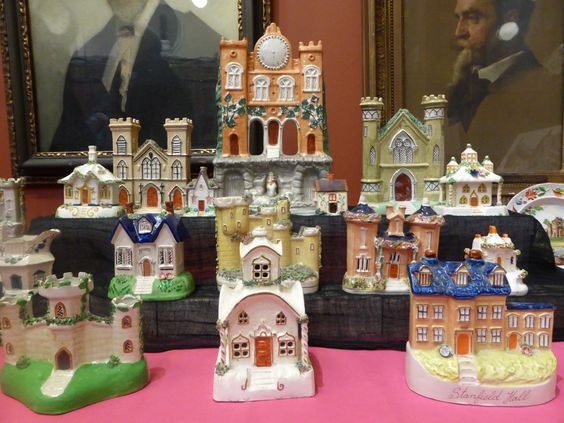Due to an availability of naturally occurring clay, salt, lead, and coal, the Staffordshire region of England was home to many manufacturers of fine English porcelains from the small forgotten factories of the folk art-based industry to the giants such as Spode, Wedgwood, Minton, Doulton, and Aynsley. Thousands of beautiful transferware patterned pieces were created and shipped to American buyers from factories in towns like Fenton, Longton, Hanley, Burslem Stoke, and Tunstall which now make up the present day town of Stoke-on-Trent.
It was, however, the colorful production of painted and glazed Staffordshire pottery figures of the Victorian era that captivated the masses. Achieving their heyday in the 18th and 19th centuries, the figures that most people collect today were painted by unskilled women and children while the men involved themselves in the production of higher end porcelains.
Their humble, hand-painted, nostalgic shapes are so easy to love. Staffordshire figures began to disappear in the late 19th century but these perennial favorites have never really gone away for long. They are definitely rooted in the hearts of Anglophiles everywhere.
Hopefully you will join the ever growing ranks of collectors of these wonderful Staffordshire figures.
emilyvanderputten on instagram.com
When it comes to English knick knacks, nothing comes close to the Staffordshire figurine in popularity.
And whether you have one piece.........
....or dozens, a Staffordshire figurine will add instant English charm to your interior.
These wonderful Staffordshire pieces, made in the area for which they are named, were manufactured for the mass market of their day. Today they are regarded as much desired and attractive collectibles.
via Pinterest
I wish I knew who to credit for this lovely Staffordshire figurines display. Please contact me if it is yours.
Lisa Farmer-Eye For Design
I have just recently fallen in love with Staffordshire figures, even though I have been aware of them for decades, and have started my own collection on display in my Welsh cupboard.
This Staffordshire shepherdess figurine was a Christmas present. Her sheep is covered with tiny broken pieces called confetti and are one of my favorite elements of these pieces.
Lisa Farmer - Eye For Design
The Staffordshire man has a confetti covered dog in his lap. Sometimes the dog on the left is referred to as a window dog because they were placed on the window sill to stand guard.
Lisa Farmer - Eye For Design
This piece is of Staffordshire lovers sitting under an arbor.
There are so many lovely pieces to collect and many reputable places to shop. Should you decide to start your own collection of Staffordshire figurines, make sure you do your homework. The reproductions are hard to detect sometimes. With knowledge and a few tips you will make good choices.
The older figurines were made using press molds and the later reproductions were made using slip molds. It is easy to tell the difference between the two as the press mold-made figurine will have a small vent hole and the reproduction will have a dime-size or large hole on the underside. Also remembner that they were made by unskilled labor so bits of glazed over debris on the bottom is desirable. Also the bottom will be entirely glazed as well. If it is unglazed it will be a repro.
Lisa Farmer - Eye For Design
It is fun to collect these Staffordshire pieces because each is unique. As you can see I have a figure like the one below yet you will often see the same figure painted in many different ways.
Older Staffordshire figurines have hand-painted characteristics. Look for noticeable brush strokes. Even across pairs the painting will not match exactly. Sponged on paint is usually typical of newer ones.
Gold lustre paint was used on older Staffordshire figures but you will find that it has dulled with age. If the gold on a figure is shiny and reflective, beware.
With most antiques a mark is desirable but not with Staffordshire. Older Staffordshire figures typically do not have any potter’s marks or factory stamps. You will find “made in England” or “Staffordshire” stamped on the undersides of newer pieces.
emilyvanderputten on instagram.com
When collecting Staffordshire figurines you must remember that naively painted decoration is the look you are after. These are not Dresden pieces.
Besides a figurine there are other types of Staffordshire figures. An English spill vase is a small vase for containing splints, spills, and tapers for transferring fire, for example to light a candle or pipe from a lit fire. There are many Staffordshire spill vases still out there to be collected.
They are also lovely as a vase for small flowers.
via Pinterest
Staffordshire flatbacks are more narrow figures that were decorated only in the front with plain flat backs because they were destined for mantles. Flatbacks were usually less expensive because their production time was less.
Images via Pinterest
During the late 1800's Staffordshire figures were in such high demand they were produced in the hundreds of thousands.
The Staffordshire dogs are what comes to mind immediately when you mention Staffordshire collecting. Decorating with these English dogs is a timeless design trend that has been popular since the 18th century. Lately there has been a revival of these figures especially in the English style home.
In fact they have even been embraced lately on the runway as seen on sweaters from Gucci resort wear.
While King Charles Spaniels became the most popular of the Staffordshire dog figures, there were also such breeds as pugs, dalmatians, greyhounds, and whippets.
Carlton Varney at the Greenbriar
The main difference between old and new is that, just like the figures of people, the old Staffordshire dogs (with virtually no exceptions) were made in press molds and new figures are made in slip molds in the process called slip casting. The dime size or larger holes left in the base of slip cast pieces are an easily detected sign of a modern reproduction.
Charles Faudree
Even though the Staffordshire figurine is a must have for the English home, they also work very well in other old world interiors.
A small vignette that pays homage to the Staffordshire dog.
I am especially fond of the Staffordshire greyhounds.
A group of white Staffordshire spaniels stand watch in this colorful English style space. White is considered the least sought after spaniel but I like them the best.
Staffordshire confetti sheep are very popular. Here is a ram and ewe pair of spill vases.
Some of the many animals made into Staffordshire figurines include parrots, chickens, horses, cows, sheep, elephants, cats, deer, lions, zebras, camels, and of course dogs.
A Staffordshire milkboy and cow.
via Pinterest
Staffordshire figures reflected the taste of ordinary English folk. The themes for the figures many times were the English monarchy, religious symbols, children, heroes, rouges, famous people of the day, and elements of country life.
Another popular theme for figurines is the Scotsman or Highlander.
pickwickantiques.com
Staffordshire figurines made into lamps are perennials favorites of English rooms.
Celeste Goulding on flicker.com
Architectural pieces offer another style figurine for Staffordshire collectors to seek out. Some people add them to their other collectibles while some collect only the little houses and buildings. These were actually called pastille burners.
A pastille burner is the term for a perfume burner in which a small lozenge is burned to remove unpleasant odors.
via Pinterest
In Staffordshire in the mid-19th century they were usually in the form of a cottage and the production of these pastille burners had become a thriving business which continued through the rest of the nineteenth century.
Just remember (if you are collecting or just planning to incorporate a small number of them in your interior) that these Staffordshire pottery figures were not considered fine by any means. Because of this there were often imperfections in the manufacturing process. There may be hairline cracks, grazing and even a chip. The good thing is, however, these small imperfections do not hurt the value of the pieces because they don't bother collectors. It's all part of the down to earth charm of these lovely figures.
Click here to see the previous post
This blog post was published by Lisa Farmer
















































